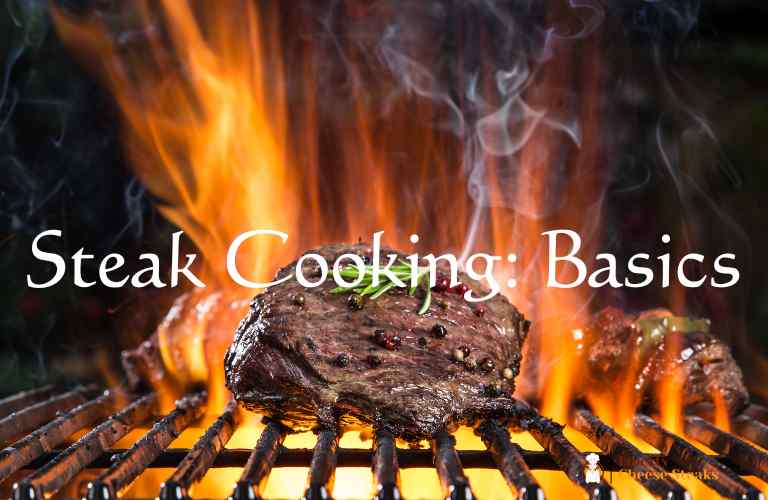Cooking a delicious steak can be a rewarding and satisfying experience. Whether you’re preparing a special meal for yourself or entertaining guests, learning the basics of steak cooking is essential.
This comprehensive guide is specifically designed for beginners, providing detailed explanations and step-by-step instructions to help you understand the concept of cooking steak properly and adequately.
Understanding Steak Cuts
Before diving into the cooking process, it’s important to familiarize yourself with the different types of steak cuts available.
Each cut has its own unique characteristics and flavor profiles, and choosing the right cut can significantly impact the taste and tenderness of your steak.
Tender cuts:
These cuts come from less-worked muscles and are known for their tenderness.

Examples include filet mignon and tenderloin. Tender cuts are typically lean and have a mild flavor.
Marbled cuts:
Marbling refers to the thin streaks of fat running through the muscle. These cuts, such as ribeye and New York strip, are prized for their rich flavor and juicy texture.
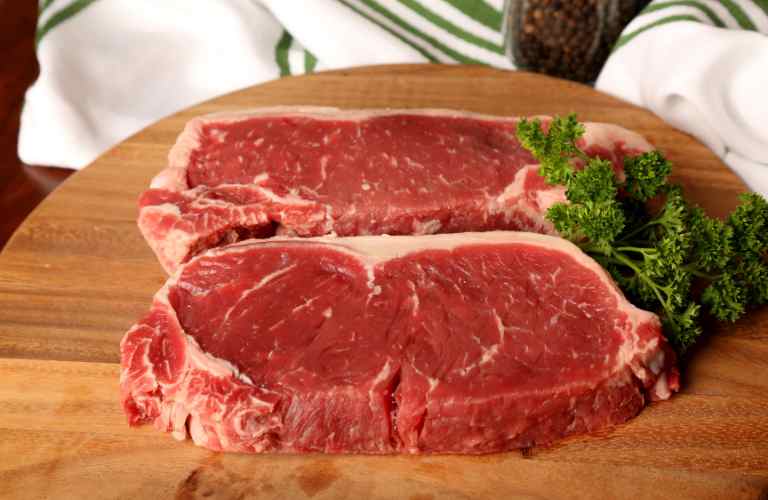
The fat melts during cooking, adding succulence and enhancing the taste.
Lean cuts:
Lean cuts, such as sirloin and flank steak, have less fat and are generally considered healthier options.

While they may not be as tender as other cuts, lean steaks can be delicious when cooked properly and can be a great choice for those looking for a leaner protein source.
Understanding the characteristics and flavor profiles of different steak cuts will help you make informed decisions when selecting the right cut for your preferences.
Selecting Quality Steak
The quality of the steak you choose plays a significant role in the final result. Here are some tips to help you select the best steak:
Shopping for steak:
Consider visiting local butchers or specialty meat shops. These places often have a wider selection of high-quality steaks and knowledgeable staff who can assist you in choosing the right cut.
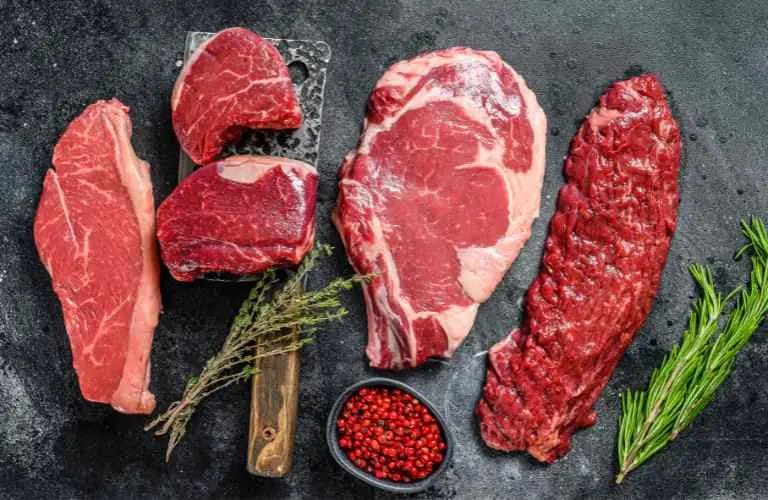
Alternatively, you can explore reputable online meat suppliers that offer delivery services.
Identifying quality indicators:
When inspecting a steak, look for the following indicators of quality:
Color and marbling:
A good steak should have a vibrant, deep red color.
Marbling, the thin white streaks of fat within the muscle, is desirable as it adds flavor and tenderness. Look for even distribution of marbling throughout the steak.
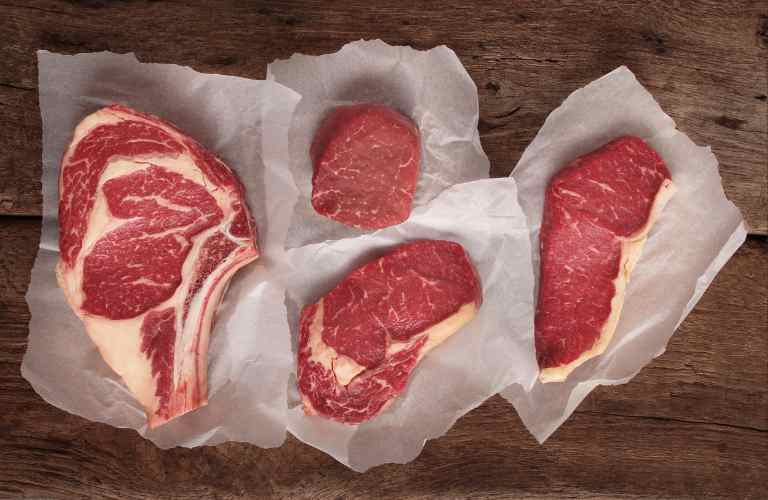
Firmness and texture:
Press the steak gently with your fingers. It should feel firm but slightly yielding. Avoid steaks that feel excessively soft or mushy, as they may be less fresh.
Avoiding excessively dry or discolored meat:
If the steak appears excessively dry or discolored, it may be an indication of improper storage or poor quality.
By considering these factors, you can ensure that you’re starting with a high-quality steak, setting the stage for a delicious culinary experience.

Preparing Steak for Cooking
Properly preparing the steak before cooking is crucial for achieving optimal flavor and tenderness. Follow these steps to prepare your steak:
Thawing frozen steak:
If you’re working with frozen steak, it’s essential to thaw it before cooking. There are two safe methods for thawing:
Refrigerator method:
Place the wrapped steak on a plate and allow it to thaw slowly in the refrigerator.
This method requires planning ahead, as it may take several hours or overnight, depending on the thickness of the steak.
Cold water method:
If you need to thaw the steak quickly, seal it in a leak-proof plastic bag and submerge it in a bowl of cold water.
Change the water every 30 minutes to ensure it remains cold. This method usually takes around 1 hour, depending on the size of the steak.
Seasoning options:
Seasoning enhances the flavor of the steak. For beginners, a simple combination of salt and pepper can go a long way in bringing out the natural taste of the meat.
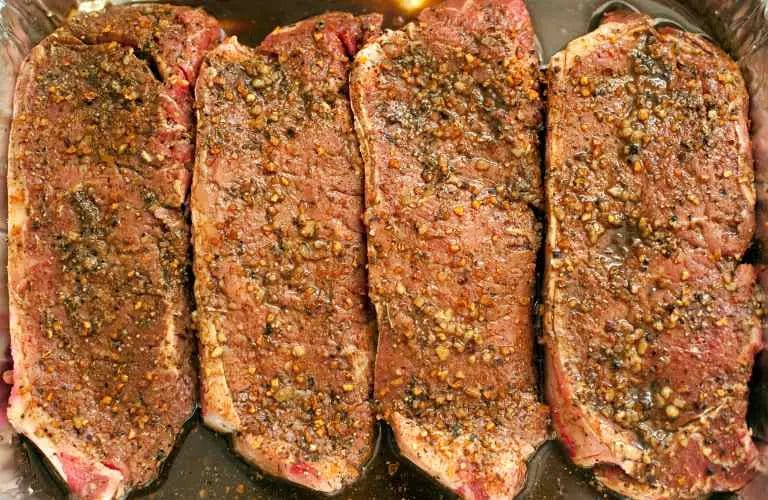
As you gain confidence, feel free to experiment with additional herbs and spices to create your own unique flavor profile.
Bringing steak to room temperature:
Before cooking, allow the seasoned steak to sit at room temperature for about 30 minutes. This step ensures even cooking throughout the steak.
Preheating cooking equipment:
Whether you’re using a skillet, grill, or broiler, it’s important to preheat the equipment before cooking. Preheating helps sear the exterior, locking in the juices and creating a flavorful crust.
By following these preparation steps, you’ll be well on your way to cooking a mouthwatering steak. In the next section, we’ll explore various cooking techniques to achieve the perfect doneness and texture.
Cooking Techniques
Now that you have prepared your steak, it’s time to dive into the cooking process. Here are some popular cooking techniques along with step-by-step instructions to help you achieve a deliciously cooked steak:
1. Pan-searing steak
Pan-searing is a great method for cooking steaks indoors, and it allows for precise control over the cooking process. Follow these steps:

Choosing the right pan:
Opt for a heavy-bottomed skillet or a cast-iron pan, as they distribute heat evenly. Avoid non-stick pans as they may hinder the formation of a flavorful crust.
Searing and finishing in the oven:
- Heat the pan over medium-high heat and add a small amount of oil with a high smoke point, such as vegetable or canola oil.
- Carefully place the steak in the hot pan. Allow it to sear undisturbed for a few minutes until a brown crust forms.
- Flip the steak using tongs and sear the other side for an equal amount of time.
- Transfer the pan to a preheated oven and continue cooking until the desired level of doneness is reached. Use a meat thermometer to monitor the internal temperature.
2. Grilling steak
Grilling is a classic and popular method for cooking steaks, imparting a smoky flavor and beautiful grill marks. Follow these steps for a great grilling experience:

Preparing the grill:
Preheat your grill to high heat, ensuring that the grates are clean and well-oiled to prevent sticking.
Direct and indirect grilling methods:
- Direct grilling: Place the steak directly over the heat source. For thinner cuts, cook for a shorter time on each side. Thicker cuts may require a combination of direct and indirect grilling for even cooking.
- Indirect grilling: Move the steak to a cooler part of the grill or reduce the heat. This method allows for slower and more controlled cooking, ensuring the steak cooks evenly.
3. Broiling steak
Broiling is a convenient method that mimics the intense heat of a grill. Follow these steps for a delicious broiled steak:
Setting the broiler:
Adjust the oven rack to the highest position and preheat the broiler on high.
Monitoring cooking time:
- Place the seasoned steak on a broiler pan or a wire rack set inside a baking sheet to catch any drippings.
- Position the steak under the broiler, ensuring it is about 4-6 inches away from the heat source.
- Cook the steak, flipping halfway through, and keep a close eye on the cooking process. The cooking time may vary depending on the thickness of the steak and desired doneness.
4. Sous vide cooking
Sous vide is a technique that involves cooking the steak in a precise temperature-controlled water bath, resulting in consistently tender and juicy meat. Here’s an overview of the process:
Equipment and process overview:
To cook steak sous vide, you’ll need a sous vide immersion circulator and a vacuum-sealed bag. Season the steak, place it in the bag, and remove as much air as possible before sealing.
Searing the steak afterward:
- Once the steak reaches the desired internal temperature in the water bath, remove it from the bag and pat it dry with paper towels.
- Preheat a skillet over high heat and add oil with a high smoke point.
- Sear the steak for a short time on each side to develop a beautiful crust.
Remember, sous vide cooking requires precision and attention to detail, but it can result in restaurant-quality steaks at home.
Determining Steak Doneness
Achieving the desired level of doneness is essential for a perfectly cooked steak. Here are a few methods to determine doneness:
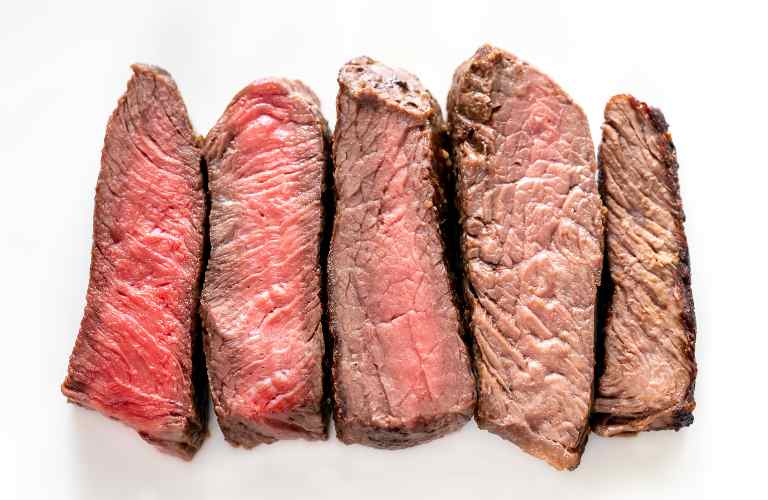
Using a meat thermometer:
The most accurate way to gauge doneness is by using a meat thermometer. Here are some general temperature guidelines for different levels of doneness:
- Rare: 125°F (52°C)
- Medium-rare: 135°F (57°C)
- Medium: 145°F (63°C)
- Medium-well: 155°F (68°C)
- Well done: 160°F (71°C) and above
Visual cues:
With experience, you can use visual cues to assess the doneness of your steak. Here are some characteristics to look for:
- Rare: A deep red center with a cool and soft feel.
- Medium-rare: A pink center with a warm and slightly springy feel.
- Medium: A pink center with a firmer texture.
- Well done: A uniformly brown center with a firm texture.
Resting steak before serving: After cooking, allow the steak to rest for a few minutes. This helps redistribute the juices, resulting in a more flavorful and juicy steak.
Serving and Pairing Steak
Now that your steak is perfectly cooked, it’s time to enjoy it to the fullest. Consider the following tips for serving and pairing your steak:
Slicing and presentation techniques:
For maximum tenderness, slice the steak against the grain. This means cutting across the muscle fibers, which shortens them and makes the meat more tender.
Popular steak sauces and accompaniments:
Enhance the flavor of your steak with a variety of sauces such as chimichurri, béarnaise, or a simple pan sauce made from the drippings.
Consider serving your steak with classic sides like roasted vegetables, mashed potatoes, or a fresh salad.
Wine and beverage pairing recommendations:
A well-paired wine or beverage can elevate your steak experience. Red wines like Cabernet Sauvignon or Malbec pair beautifully with red meat, while lighter-bodied wines like Pinot Noir complement leaner cuts.
Alternatively, you can explore craft beers, whiskey, or non-alcoholic options such as sparkling water or flavored mocktails.
Troubleshooting Common Mistakes
Even with the best intentions, mistakes can happen. Here are some common mistakes and how to troubleshoot them:
Overcooking steak:
If your steak turns out too well done or dry, try marinating it beforehand or using cuts with higher fat content.
Alternatively, consider using a meat thermometer to achieve the desired level of doneness.
Undercooking steak:
If your steak is undercooked, finish it in the oven or on the grill to reach the desired temperature without overcooking the exterior.
Use a meat thermometer to ensure it reaches a safe internal temperature.
Unevenly cooked steak:
Uneven cooking can occur if the steak is too thick or if the heat distribution is uneven.
To avoid this, consider using a meat tenderizer to flatten thicker cuts or adjust the heat source to ensure even cooking.
Conclusion
Cooking a delicious steak is an art that can be mastered with practice and understanding. By learning the basics of steak cooking, selecting quality cuts, and employing the right techniques, you can create a memorable dining experience.
Remember to experiment, be patient, and enjoy the process. With time, you’ll develop your own techniques and preferences, creating perfectly cooked steaks every time. Happy cooking!
What is the best way to determine the doneness of a steak without using a meat thermometer?
While using a meat thermometer is the most accurate method, you can also rely on visual cues and touch.
As mentioned earlier, the color, texture, and firmness of the steak can provide clues.
For example, a rare steak will have a deep red center that feels cool and soft to the touch, while a well-done steak will have a uniformly brown center with a firmer texture.
Can I marinate the steak before cooking?
Absolutely! Marinating can enhance the flavor and tenderness of the steak. You can use a variety of marinades, such as a combination of oil, acid (such as citrus juice or vinegar), herbs, and spices.
Marinate the steak for at least 30 minutes or up to overnight in the refrigerator before cooking.
Is it necessary to rest the steak after cooking, and for how long?
Yes, it is highly recommended to let the steak rest after cooking. Resting allows the juices to redistribute throughout the meat, resulting in a more flavorful and tender steak.
As a general rule, let the steak rest for about 5-10 minutes before slicing or serving.
What should I do if my steak is too salty?
If your steak turns out too salty, you can try a few methods to mitigate the saltiness. One option is to slice the steak into smaller pieces and serve it with a milder side dish or sauce.
Another option is to balance the saltiness by adding a squeeze of citrus juice or a sprinkle of sugar to the steak before serving.
Lastly, you can also try diluting the saltiness by serving the steak with a starchy side like mashed potatoes or bread.
Can I reuse the marinade for basting or as a sauce?
It is not recommended to reuse the marinade that has come into contact with raw meat. However, you can use the marinade as a basting sauce if you boil it first to kill any bacteria present.
Alternatively, you can set aside a portion of the marinade before adding the meat and use it as a sauce by simmering it on the stovetop to cook off any raw meat contaminants.
What is the ideal thickness for a steak?
The ideal thickness of a steak depends on personal preference and the cooking method you choose.
Thicker steaks, typically around 1 to 1.5 inches thick, are suitable for methods like grilling and broiling.
Thinner cuts, around 0.5 to 1 inch thick, are ideal for pan-searing. Adjust the cooking time accordingly based on the thickness of your steak to achieve the desired doneness.
Can I cook frozen steak without thawing it first?
While it is generally recommended to thaw the steak before cooking for even and consistent results, you can cook frozen steak in certain circumstances.
However, note that the cooking time will be longer, and it may be more challenging to achieve a perfectly cooked steak.
If you choose to cook frozen steak, adjust the cooking time accordingly and use a meat thermometer to ensure it reaches the appropriate internal temperature.
Can I reuse the oil or fat used for cooking steak?
It is generally safe to reuse cooking oil or fat if it has not been excessively heated or contaminated.
Strain the oil or fat after each use to remove any food particles, and store it in a cool, dark place.
However, it’s essential to use your judgment and discard the oil if it appears discolored, has a rancid odor, or shows signs of spoilage.
How can I achieve a perfectly seared crust on my steak?
To achieve a beautifully seared crust, ensure that your cooking surface, whether it’s a pan or grill, is properly preheated. Make sure the steak is dry before adding it to the hot surface to promote browning.
Avoid overcrowding the pan or grill, as it can lower the temperature and prevent proper searing. Finally, refrain from flipping the steak too frequently to allow a crust to form.
What should I do if my steak is too tough or chewy?
Tough or chewy steaks can be the result of using a cut that requires longer cooking times or improper cooking techniques.
To make tough steak more tender, consider marinating it to break down the muscle fibers, or opt for slower cooking methods like braising or slow roasting.
Additionally, ensure you slice the steak against the grain when serving to make it easier to chew.
How do I clean and care for my grill or pan after cooking steak?
After cooking steak, allow the grill or pan to cool down slightly. Use a grill brush or a non-abrasive sponge to remove any residue or food particles from the grill grates or pan surface.
If using a grill, you can also heat it on high for a few minutes to burn off any remaining food particles.
For pans, wash them with warm soapy water and use a non-metal scrubber if needed. Dry the grill grates or pan thoroughly to prevent rusting.
What is the difference between dry-aged and wet-aged steaks?
Dry-aged and wet-aged steaks are two methods of aging meat to enhance tenderness and flavor.
Dry-aged steaks are exposed to controlled environments with controlled humidity for several weeks.
This process allows enzymes to break down the muscle fibers, resulting in a more tender steak with intensified flavor.
Wet-aged steaks, on the other hand, are vacuum-sealed and aged in their own juices for a period of time. They retain more moisture and tend to have a milder flavor compared to dry-aged steaks.
Can I cook steak in a slow cooker?
While slow cookers are primarily used for long, low-temperature cooking methods like braising or stewing, they are not typically recommended for cooking steak.
Steak is best cooked using high-temperature methods to achieve a desired level of doneness and to develop a flavorful crust.
Slow cooking in a liquid environment may result in overcooked and potentially mushy steak. It’s best to use alternative methods like grilling, pan-searing, or broiling for cooking steak.

